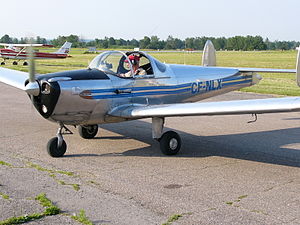Sanders Aviation
| Ercoupe | |
|---|---|
 |
|
| 1956 model Forney F-1 | |
| Role | Light aircraft |
| National origin | United States |
| Manufacturer | Engineering and Research Corporation |
| Designer | Fred Weick |
| First flight | 1937 |
| Produced | 1940–1969 |
| Number built | 5,685 |
| Unit cost |
US$2,665–9,295 (1941)
($43.4 thousand–151 thousand in 2016 dollars) |
| Variants |
Alon X-A4 Aircoupe Mooney M10 Cadet Bryan Autoplane |
The ERCO Ercoupe is a low-wing monoplane aircraft that was designed and built in the United States. It was first manufactured by the Engineering and Research Corporation (ERCO) shortly before World War II; several other manufacturers continued its production after the war. The final model, the Mooney M-10, first flew in 1968 and the last model year was 1970. It was designed to be the safest fixed-wing aircraft that aerospace engineering could provide at the time, and the type continues to enjoy a faithful following.
In 1931, aeronautical engineer Fred Weick was assistant chief of the aeronautics division of the National Advisory Committee for Aeronautics (NACA). In 1934 he asked permission to build an aircraft based on the 1931 Stout Skycar, using fabric instead of aluminum covering, and control modifications based on NACA research. Weick and a group of co-workers designed and assembled the experimental aircraft with a group of his colleagues who worked on the project in their spare time and paid for it themselves. The resulting aircraft, known as the W-1, featured tricycle landing gear, a parasol wing, and a pusher propeller configuration.
Fred Weick listed the W1 design goals that were tested in later seminars:
In 1934 the Bureau of Air Commerce approached Weick's team looking for standards for a competition for a safe and practical $700 aircraft. In 1936 the winner of the competition was the Stearman-Hammond Y-1, incorporating many of the safety features of the W-1. Two other winners were the Waterman Aeroplane and a roadable autogyro, the Autogiro Company of America AC-35. The W-1 was not intended for production to qualify as a competitor, but was purchased by the Bureau for continued experimental tests in spin-control safety. After the prototype W-1 underwent a forced landing, an updated W-1A was built by Fairchild, incorporating leading edge cuffs.
...
Wikipedia
